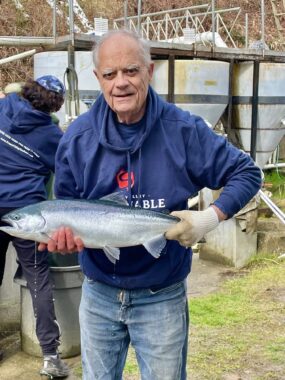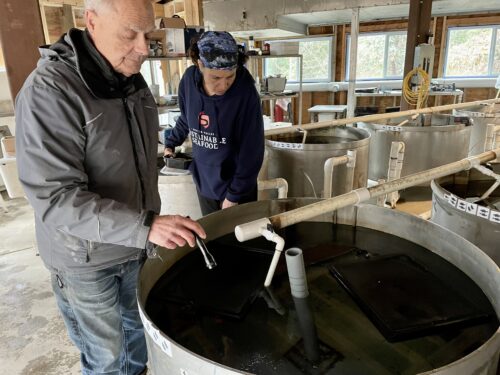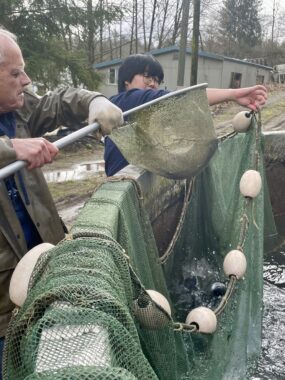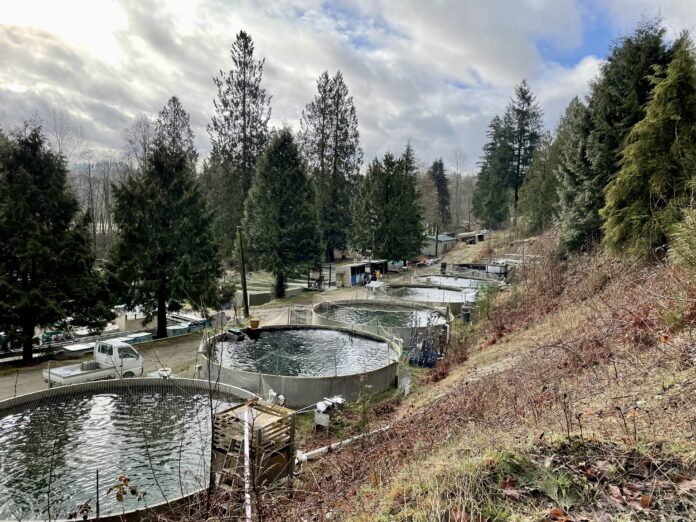After over two decades of trial and error, a Canadian freshwater fish farmer has overcome the challenges that come with farming sockeye salmon (Oncorhynchus nerka) and he is now able to consistently produce disease-free fish of 3 to 6 lbs without the use of therapeutics and chemicals.
“We find that the juveniles would grow well during the first and second year, but in the third year, they begin to express mortality mainly from stress-related diseases such as gill and fin rot,” says fish farmer Lawrence Albright, who owns half of the Richard Henly Fish Farm operation, a 50,000-lb-a-year inland freshwater farm in Langley, British Columbia.
He now says he’s nailed down a technique that reduces the mortality rate significantly.
“We’ve figured it out. If we put about 3,000 in the tank, we get about 20 dead in the first several years of culture, maximum, and marginally more dead in the third year of culture.”
“The problem is that when you make mistakes in the culture of this fish, the fish couldn’t tell you. And very often times, three months later, they start to die because of the amplification of disease either inside the animal or on its integument. In the early days, we lost many if not most of the fish. We had to solve those problems.”
There were other farmers in Canada that have tried to farm sockeye over the past several years, but the fish were susceptible to bacterial diseases notably, bacterial kidney disease (BKD). There is a farmer in New Zealand that’s giving sockeye aquaculture a go, and it is reportedly 3 to 4 years from commercial harvest. SalmonBusiness can confirm that Albright is so far the only sockeye farmer in BC and the rest of Canada.
“There were nine farms in BC back in 1989 that tried it, and they all failed. I was one of them. It didn’t work. I was the only one who kept at it,” he says. “Seven years ago, I figured it out. I said: ‘I know what to do now.”
Challenges

This is the first year Albright has sockeye this large that will officially be going to the market. The fish in the pens were on their third winter when this reporter visited the farm in early spring. Albright says it took this long because sockeye are a “12” in a difficulty scale of one to 10.
“Growing rainbow trout is a 1 – it’s the easiest; Coho is a 2; Chinook is a 3; sockeye is a 12 – it is extremely difficult. I’ve never grown Atlantic salmon so I cannot speak on that,” he says.
Albright isn’t about to reveal his secret formula; after all, he’s a businessman. All he’s willing to say is that anyone’s preconceived notions about how to grow salmonid shouldn’t be forced on sockeye because “those don’t work.”
“I figured out what to do from observations,” he says. “All fish require certain things, but like all fish, sockeye can’t tell you what they want. And you only get one chance to grow them over a three-year period. And sometimes they express low growth or disease months after you made a mistake. We’ve figured out how to do it, what to do, and we have a good idea of the theoretical background why it is so difficult and why we can do it.”
Starting with “very good fry” is essential, he says. The generation currently in the farm is F3, or the third generation that’s been domesticated from brood stock harvested from the Pitt River in BC some 10 years ago.
“The government, for the last 10 years, has not allowed anyone to take sockeye from the wild anymore for aquaculture because there’s not enough sockeye. This will inhibit the industry. But we have a complete farm here. We take the adults and they produce sperm and eggs, we mate them and start again. So we have the complete lifecycle here in-house.”

Albright says he’s open to offering seed stock to other farms that might be interested in growing sockeye. “They would have to do it under our guidance,” he adds.
Marketing sockeye

Pablo Rodriguez, the Vancouver-based president of luxury food purveyor Mikuni Wild Harvest, is the farm’s first customer. Mikuni prides itself as distributor of “the rarest and most unique food items” from around the world, so distributing the world’s only farmed sockeye production fits the bill.
“Someone told Larry 25 years ago that he would not be able to farm sockeye. And now, some 20 years later, he has a program going and he’s very close to homerun,” he says.
Rodriguez market-tested the product in the summer of 2020, the first year Albright started seeing 5-lb sockeye.
“It had a different smell. It didn’t smell like fish. Then it got a little bit better, the feed ratios were worked out, and Larry – you have to remember he approaches this from a very scientific position – he’s not looking at the market at that point; he was looking at building the most beautiful sockeye through his work.”
Secondly, the colour of the flesh wasn’t – and still isn’t – the same deep red that wild sockeye salmon is famous for. But Rodriguez says it’s a matter of educating customers.
“As we’re educating the customers about the story, there is definitely no rejection of the product.”
Albright recognizes the challenge. “The problem is the diet of sockeye in nature is a lot of crustaceans which have a lot of astaxanthin because they eat zooplankton, which in turn eat the phytoplankton.”
Rodriguez believes in the farmed sockeye’s potential to develop a niche market. “Over the next five years, I think sockeye will have a very nice place in the industry. It’s a better-quality fish. I really believe that. It’s a much prettier fish.”
The challenge now would be to scale up the farm’s operations to commercial scale and produce various size ranges consistently, says Rodriguez, noting that this is something that farmers of Atlantic salmon have already mastered.
“You’d want to have 2-5 lbs then 4-6 lbs. That kind of range. And you have to have it consistently. It’s hard to build a menu when you don’t have enough of that size of fish. If the fish ranges are different, it’s hard to train the people behind the kitchen to cut the right portions. It reduces the range of market share that you can sell into when certain guys want only 2.5 lbs and you have only 1.5 lbs.”
Albright agrees. His to-do-list now includes scaling up the farm, which also produces trout as its main crop. The farm is currently operating only at 15 percent of its approved capacity. “There’s still a lot of room to grow,” he said.

